Film Room: Breaking down how Virginia has used its tight ends
Editor’s Note: This is the first installment in our summer series breaking down UVa’s schemes, concepts, and personnel as the Hoos head toward the fall and presumably the 2020 football season.
UVa's offense has had more consistent success through the air in the Bronco Mendenhall/Robert Anae era than at any other time in school history. Both of Virginia's starting quarterbacks set school records for passing yards in a season over the past four years and the Wahoos have produced several productive wide receivers, a couple of which are on NFL rosters today.
While the focus of UVa's success through the air has mostly been on the play of the quarterbacks and wide receivers, the tight end position has been a bit of an afterthought. Many Cavalier fans that remember the Al Groh days when UVa was the de facto “Tight End U” clamor for the tight end to be a bigger part of the passing game, although the game has changed considerably since those days.
But the ways in which the tight end is used showcases how UVa’s offense relies on confusing the defense with tons of pre-snap alignments and motion, position groupings and similar-looking concepts that can go in a variety of directions.
So today, we’re starting our Film Room series breaking down how UVa used the tight end position in 2019, particularly in the short to intermediate passing game.
Production
Virginia completed at least one pass to a tight end in each of its 14 games in 2019 but no more than four completions in a game. The position had its biggest impact in the passing game in the win at North Carolina, with season highs in receptions (four), receiving yards (66) and touchdowns (two) between the two pass catchers.
Departing senior Tanner Cowley received all but one of Virginia’s targets to tight ends on the season. Of Virginia’s 521 passing attempts on the season, he was targeted 37 times, for a 7-percent target rate. For perspective, that’s 10 fewer targets than UVa’s fourth-most targeted receiver (Billy Kemp) and 13 more than the next-most targeted player (Terrell Chatman). Cowley recorded 28 receptions for 311 yards, and one score. His backup, Grant Misch, caught just one pass for 6 yards and a score.
UVa threw the ball more in 2019, and as a result, the tight end was a bigger part of the offense overall. In 2018, the Cavaliers attempted 359 passes, or 27.6 per game. Tight ends Evan Butts and Cowley combined for 27 targets in 2018 and hauled in 20 receptions for 209 yards and two touchdowns, with Butts getting a lion’s share of those targets.
Last year, Virginia threw the ball 37.2 times per game. So while the tight end’s role in the passing game specifically was about the same across the two years (around 7-percent target rate), the significant increase in passing attempts made the tight end position more valuable than it was the previous year in comparison to running back and quarterback run production, which were both down last year from 2018.
Deployment
According to Pro Football Focus data, Cowley played 751 snaps in 2019, lining up in a few different spots. Virginia’s offense features a lot of different formations and personnel groupings with many overlapping concepts that can be run from different looks (more on this in a future piece).
From any of these alignments, the tight end can be used to run block, pass block, or as a receiver. There aren’t a lot of obvious giveaways in tight end alignment in Virginia’s scheme that would tip a defense off to the play. UVa also uses a lot of pre-snap motion, so the tight end could line up in the backfield and then shift up to the line of scrimmage, or start out wide and go in motion to the other side, etc.
Below, we’ve broken down the most common alignments in UVa’s many formations.
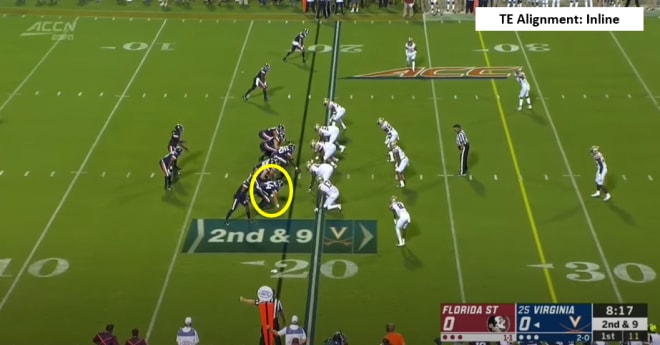
Inline Alignment:
This was the most-common alignment for the tight end in 2019 and probably the alignment that most football fans associate with the position, particularly in an “old school” offense. Some 428 of Cowley’s 751 snaps were as an inline tight end, lined up next to the left or right tackle with his hand in the dirt. This look is the one that Cowley would be most likely to block out of and would be used in a lot of short-yardage or running situations.
The inline look could also be a “max protect” where UVa tries to maximize time for the quarterback to find a receiver down the field or hold off a blitz to allow the receivers to get into their routes before pressure arrives. Cowley was used as a pass protector 158 times in 2019 and almost all of those plays would fall under that category.
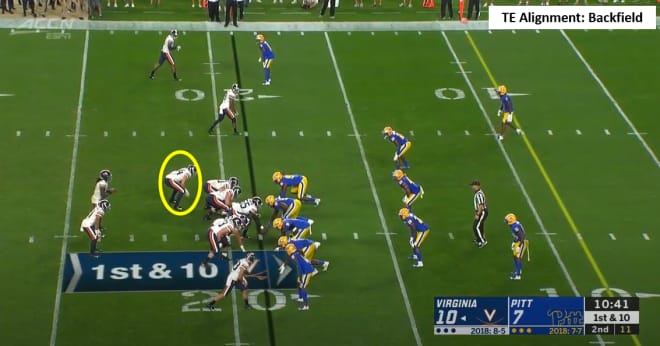
Backfield Alignment:
The second-most common alignment for Cowley was in the backfield. This could mean he would be lined up next to Bryce Perkins, but more commonly it simply meant he was lined up off of the tackle position but a yard or so behind the line of scrimmage. This was a look UVa ran quite a bit, sometimes with pre-snap motion from the tight end, and many of the passing concepts we break down below come from this look.
But again, this formation doesn’t necessarily give anything away in that regard. UVa lined Cowley up in the backfield 145 times and many of his assignments from this spot were run blocks.
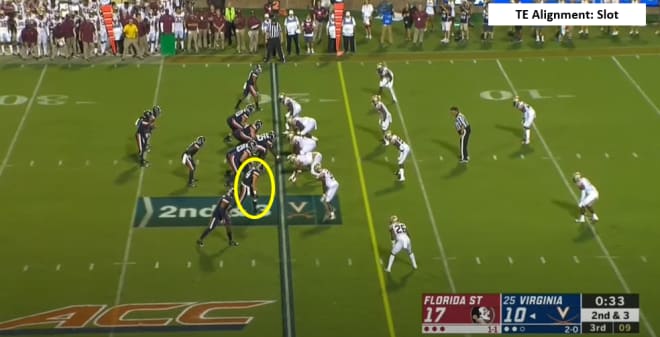
Slot Alignment:
While the inline alignment would be associated with more traditional brands of football (think how Heath Miller was used at Virginia), the slot alignment is more of a modern use for the tight end. Think about how the New England Patriots used Rob Gronkowski, or the Kansas City Chiefs with Travis Kelce. They can certainly line up on the line of scrimmage, but the tight end position has evolved from being a blocker first and a pass catcher second to the best at the position basically becoming big, physical receivers that can create mismatches with smaller defensive backs or slower linebackers, and blocking is more of a secondary function.
The tight end in UVa’s offense has more of a blended role, with plenty of blocking and route running. Of Cowley's 751 snaps on offense, he ran 331 routes (44 percent) and blocked 420 times (56 percent). In the play below, Cowley is lined up in the slot, where he set up on 141 plays in 2019.
On the play above, Cowley’s slot alignment is barely off the line of scrimmage, which is a great place to block from, particularly back towards the middle of the fields on sweep plays to his side, or run routes from. From this slot position, he can quickly get up field or cross the quarterback’s eyes.
The tight slot is also a great position to get to soft spots in zone coverage, which are often in that area just off the line and inside the hashes, or out into the flat with receivers there to clear out space and block downfield if the tight end is targeted. The same applies to the offset backfield look above.

Two TE Set:
Misch played 171 snaps on offense in 2019 and saw action in all 14 of UVa’s games. His usage increased when UVa had a big lead (Duke, William & Mary, and Liberty), and many of those snaps were in relief of Cowley with the game out of hand. His primary role on offense was as a blocker: Of his 171 snaps, 127 were run blocking assignments, and 22 were pass blocking assignments. He ran just 22 routes on the season, and most of those assignments came in the second half of the season.
Unlike Cowley, Misch wasn’t used in the slot or out wide very often. He lined up as an inline tight end on 146 of his 171 snaps and in the backfield (mostly in the previously described off-tackle look) for 20 more. On the play above, Misch and Cowley saw action on the same play. These looks were almost exclusively short-yardage and goal-line situations where an extra blocker was preferred to an extra wide receiver. On this goal-line TD run for Wayne Taulapapa, Misch was lined up inline on the right side, with Cowley in the slot left. Virginia also had a two TE set for Misch’s touchdown catch against UNC.
(NOTE: Cowley also lined up out wide on 35 plays, but those plays were pretty few and far between in the course of a 14-game season.)
UVa's Tight End Concepts
Almost all of the passing concepts involving the tight end are plays that are designed to go there, or the tight end is one of the primary reads. Another commonality is that most of the throws are short and near the line of scrimmage.
Of Cowley’s 37 targets, 30 came on throws within 10 yards of the line of scrimmage, and 10 were behind the line of scrimmage. Cowley had six catches between 10 and 20 yards, mostly up the seam, and just one target on a throw longer than 20 yards (an underthrown ball down the sideline that could’ve been a touchdown if thrown more accurately.) Of his 311 receiving yards, 224 (or 72 percent) came after the catch.
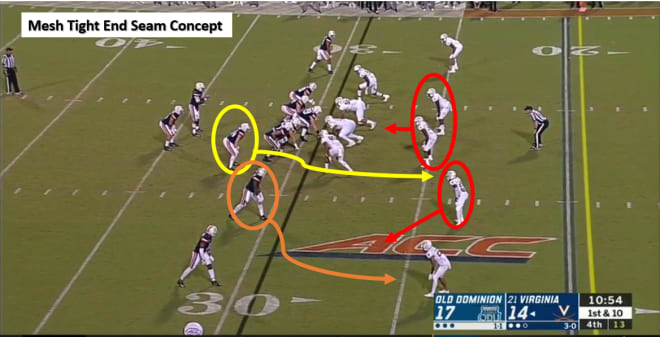
Seam Concept:
On this play against Old Dominion, Cowley is lined up in the backfield, just off right tackle. Joe Reed is in the slot, with Taulapapa and Perkins in the backfield.
In the clip below, you’ll see how a quick fake to Taulapapa coupled with a pause makes the play look like a potential quarterback keeper. Both middle linebackers, who were probably told all week to focus on No. 3 first and foremost, get sucked in on the fake to Taulapapa (and potential QB keeper) and vacate the middle of the field. The offensive line shows a run block look, and Ryan Swoboda (RT) moving his target to the right creates a nice throwing lane for Perkins.
To open up more space, Reed clears out of the middle of the slot towards the sideline. ODU’s nickel back is in man coverage and is forced to follow Reed out, which gives Cowley a lot of space to simply come off the line of scrimmage and wait for the throw.
As soon as Perkins sees the linebackers move towards him, he knows he has an easy throw and catch.
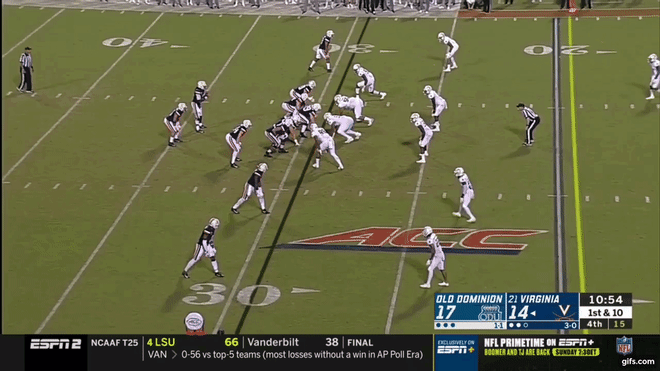
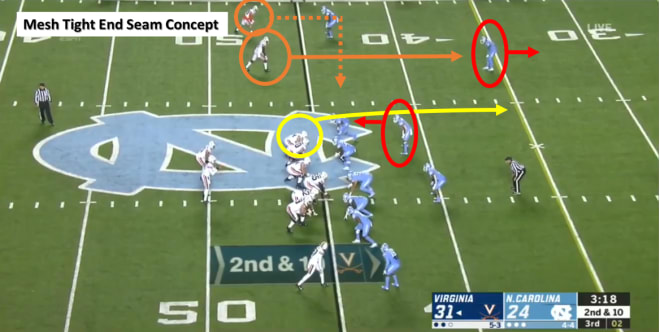
Here’s another example of a similar play from a different formation, this time in the win at Carolina. On this play, Cowley is lined up on the as an inline tight end on the left side. To his left, Reed is in the slot and Kemp out wide. Notice the wide splits between the two receivers and the line of scrimmage. On the previous play Reed was lined up closer to the ball, but then took his route (and the defender) out towards the boundary. On this play, the wide alignment gives more space for a throw.
As far as the tight end is concerned, this play is virtually the same as the last one. Perkins is going to hold a fake with the running back to draw in defenders and try to throw over their heads when they move up. The route concept on the left side is different, however, and it gives Perkins another good option for an easy completion. On this play, Reed will run a go route and take the deeper defender with him. UNC is playing off, so Kemp, lined up out wide, can sneak in behind Reed and run an in route back towards Perkins. Cowley is the primary read, and if the inside linebacker lined up over him takes him down the field, that will open up the entire left side of the field for an easy throw to Kemp, who is going to beat the DB on an in-breaking route here because it’s very difficult to stop unless the receiver slips or just runs a route that isn’t crisp.
None of that matters, though, because the inside linebacker gets sucked in by the run fake and likely is even more concerned about Perkins taking off to the left side, knowing his defensive backs are going to be occupied with their coverage, and the fact that Perkins ran for a 65-yard touchdown off the left side earlier in the quarter. His decision is a big mistake, as he lets Cowley go, likely assuming the safety will be able to pick up the route, and Perkins (or a quick handoff) are the top priority. But the very wide alignment of the wide receivers draws that extra defensive back, who would normally be lined up closer to the middle of the field, out further, leaving the space behind the linebacker wide open.
On this throw, Perkins puts it on the money for a big gain. UVa would come back to this play in the Orange Bowl, with Cowley lined up on the right side and it went for a gain of 53 yards.
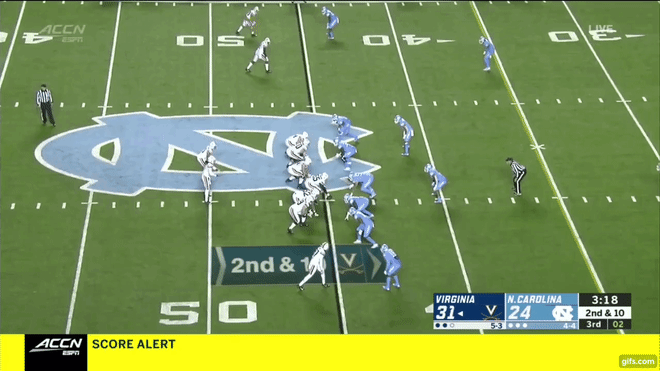
Here’s another similar look to the last one. Check the wide receiver splits on the top of the screen. Again, Reed and Terrell Jana are almost lined up outside the numbers, drawing the safety over. UNC’s defenders are probably looking for a pick play here, where Jana runs up field and cuts off the two defenders and Reed sneaks in behind him on a slant from the outside. They can’t afford to not have two defenders lined up wide, especially when UVa needs just nine yards to score. Reed simply turns towards the line of scrimmage, indicating a screen, and that’s enough to pull everyone at the third level away from the middle of the field.
With the safety out of the picture, all Perkins has to do is step towards the line of scrimmage, bait the defenders in, and then throw over the top. This was probably one of the easiest throws of his career and an easy touchdown.
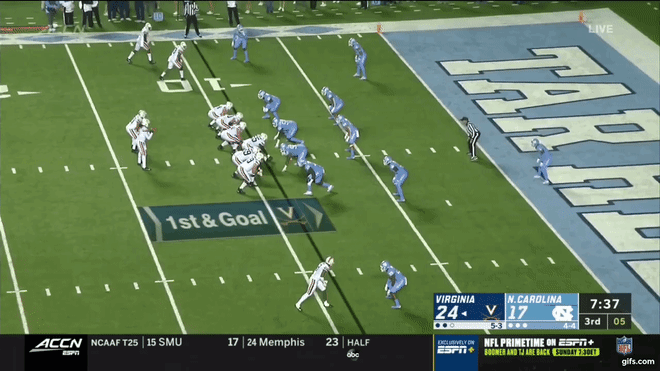
Releases, Delays and Screens
This is a pretty standard tight end passing concept that many teams implement in different ways. The pre-snap alignment of the tight end can give an offense a lot of delayed route options. UVa uses a lot of formations and personnel groupings, and will run similar plays from different looks, which can confuse a defense that had just a few days to prepare for everything that they’ll see in the game.
UVa ran a lot of delayed route concepts with Cowley in 2019, where he froze or chip blocked for a second, and then released into open space. Things happen so quickly on a football field and releasing a receiver late can be very effective for an offense, especially since it creates a lot of easy, quick throws as protection begins to break down, almost like a designed screen pass. When the ball is snapped, defenders with coverage assignments quickly identify who is going out on routes and who is protecting.
If a tight end in the area takes a step back and looks to block, defenders can simply forget about him and focus on other route runners in their area. Then, when the tight end releases, it’s too late to recover before they make the catch.
Middle Release Concept
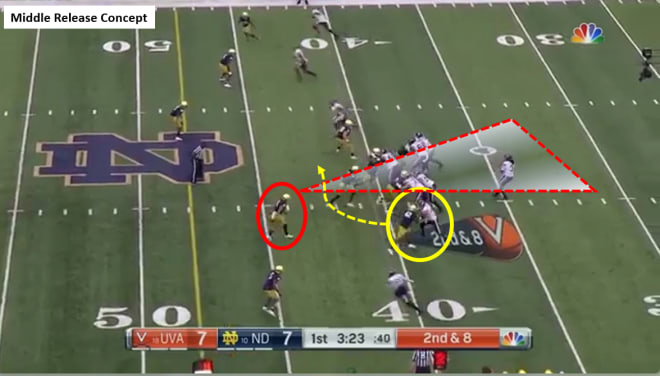
On the play above, Notre Dame is bringing a linebacker on a blitz, so safety Aholi Gilman comes up to cover the middle of the field. At the snap Cowley, lined up inline on the left side, chips the pass rusher and Gilman’s eyes move to the backfield. He forgets about Cowley, who releases off of his block after a second and darts into the middle of the field. Perkins sees that Gilman isn’t following Cowley on the release, and makes an easy throw for a 23 yard gain (below).
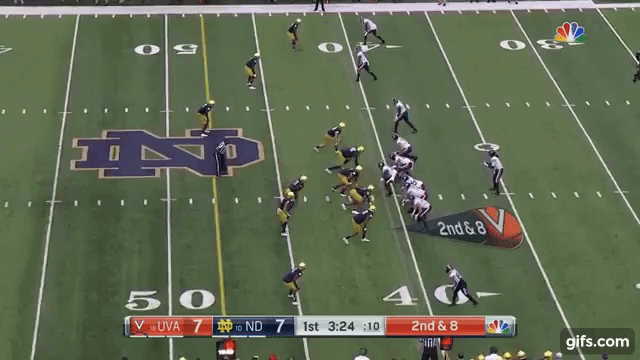
Fake Max Protect Screen Concept
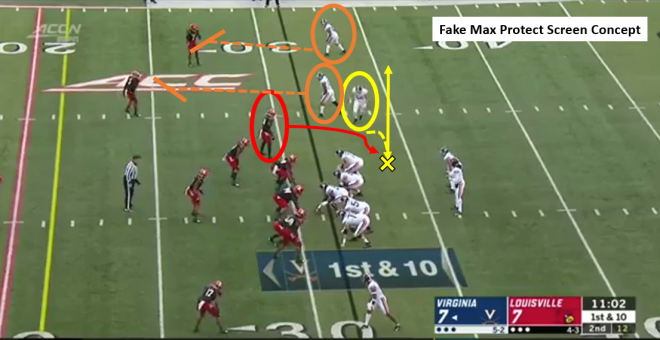
The next play (above) is a similar delay or chip block concept, but from a different formation and to a different area of the field. Cowley starts out in the slot and motions back to the line of scrimmage, seemingly to pick up a blitzer off the edge in a “max protection” play. Instead, he pauses at the snap to show block but then rolls out to the flat for the catch.
This play is a de facto screen to Cowley, as you can see the two receivers on the far side anticipating the catch and preparing to create a lane for Cowley to run in with seal-off blocks. When the TE goes in motion to the end of the line, notice the two defensive backs on the far side take a couple of steps back, anticipating that Cowley will block, so the pass will go down the field. Nobody forgot about Cowley on this play, it was simply two defenders for two blockers and a receiver, and the result was a nice gain (below).

TE Flat Screen Concept
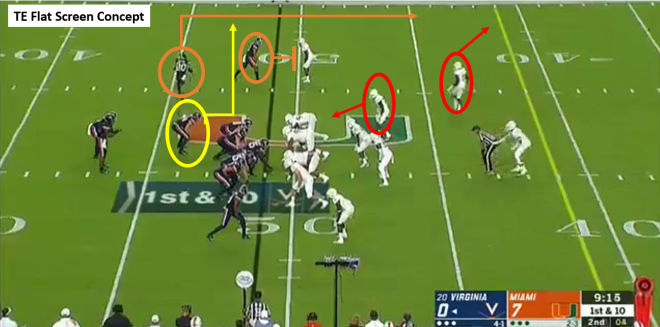
Here’s another pass to Cowley in the flat. This time, he lines up just off the line of scrimmage and doesn’t go in motion. Instead, Kemp comes across from right to left, causing a shift in defensive alignment. A defender comes with him, signaling man coverage. The outside linebacker (highlighted in red) would be the player assigned to Cowley. If he takes him into the flat, Perkins could hand the ball off or, more likely, take off and run into the vacated space off left tackle. Instead, the linebacker freezes and comes up towards the ball, and Perkins can toss it out to an open Cowley, who works around the block from Jana towards the sideline (below).
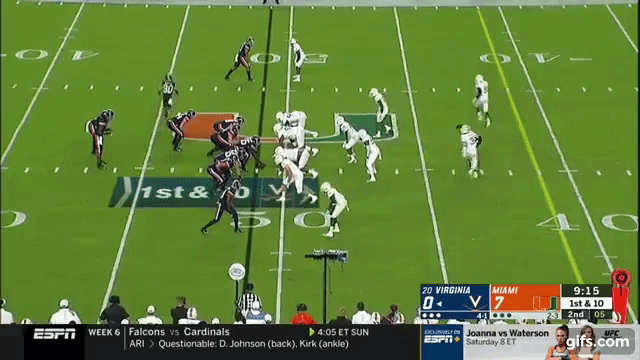
TE Cross Flat Concept
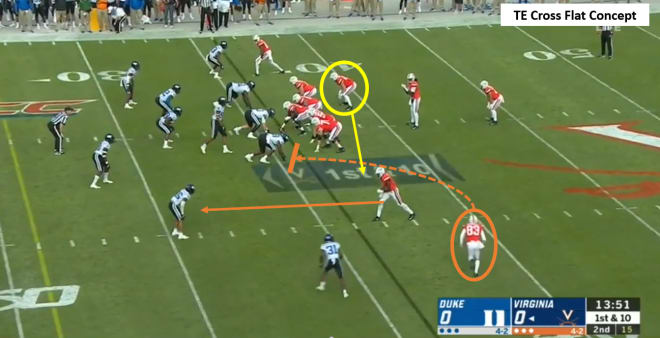
Here’s a different look that accomplishes a similar result. On this play, Cowley lines up off the right side of the lin in what is designed to look like a run to the right side for Taulapapa. Duke is in man coverage, so Hayden Mitchell (bottom) going in motion brings the corner (No. 31) with him. He’s able to crash towards the line of scrimmage and form a seal block which opens up the entire right side of the field for Cowley, coming across the line of scrimmage (Reed runs a go to pull his defender out of the way). The blocking is designed to look like a run right including Cowley, who could be sealing the left side of the hole with a cross block (UVa uses this concept in the run game all the time). Instead, Cowley simply continues across Perkins’ face until he is beyond the left tackle and then gets an easy catch and run. Watch how effective this pre-snap look and post-snap blocking action is on the second level defenders, who all get fooled by the play action (below):
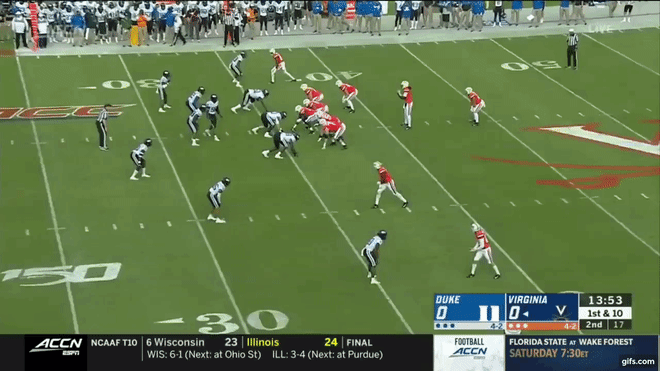
Here’s another similar play run against Clemson. There’s no motion this time, though, just two receivers static on the near side. Notice how Misch lets the end on the nearside of the line go into the backfield before Perkins makes the throw. This is the same concept as the play above against Miami, where the end is released like a read-option play, in hopes that he’ll crash towards Perkins and create more space for Cowley to run. Cowley’s run after catch is also similar to the plays against Duke and Miami, with the receivers, this time Jana and Dontayvion Wicks, blocking back towards the middle of the field to open up the sideline and force Clemson’s free defenders in the middle of the field to chase the ball carrier all the way out to the sideline to make the tackle.

The 2020 Outlook
Every play above featured Cowley, who will not be on the team this fall. In his place, UVa will turn to Misch, who served as his understudy of sorts in 2019. Misch was targeted just one time in the passing game, but it was a productive play, going for a six-yard touchdown in the second half of the win in Chapel Hill (below).
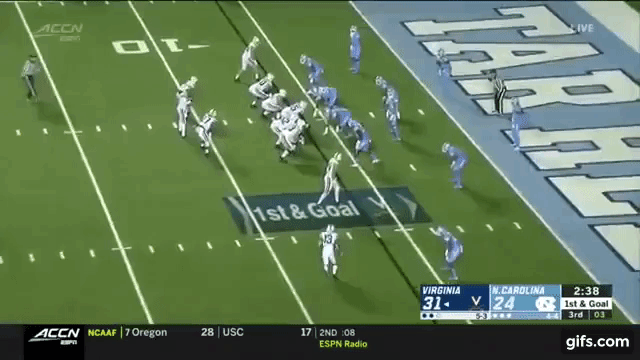
Misch figures to get more targets this season and could start to get the deployment that Cowley saw last season. A converted defensive lineman, Misch was used last year almost exclusively in a blocking role. He posted decent run blocking numbers and at a minimum will certainly be used as a blocking tight end going forward.
UVa also added freshman Joshua Rawlings, a physical tight end prospect with the tools to be a versatile weapon in the Virginia offense. Rawlings enrolled early and is listed at 6-foot-5, 245 pounds. It wouldn’t be surprising to see UVa find a role for him in the offense, particularly if Misch isn’t able to fill Cowley’s role as adequately as the coaching staff would like.
But the plays broken down above show that while Cowley was a crafty, overlooked commodity for the offense, a lot of what he was able to do was good scheme work. UVa didn’t throw to the tight end a ton or design plays for the tight end, so it was almost a “change-up” of sorts when they would call one of these designed looks.
The tight end’s role in 2020 will depend greatly on how effective UVa is running the football. Outside of Perkins, UVa’s run production just wasn’t consistent enough in 2019 to be counted on to move the chains. As a result, Cowley was used a lot in the short passing game with blocking concepts that allowed him to drift into space, catch the ball, and follow designed blocks.
Part of the reason tight end throws weren’t more common is the fact that they were effectively misdirection plays. So many of them came off of run looks or relied upon freezing or fooling the defense long enough to set up blocks for the yards after the catch. If the Cavaliers tried to run those looks 10 times a game, they would stop being effective. It’s the same reason team’s don’t throw 10 screens to the running back in a game. If the Hoos can run the ball better next year, they might not need to use so many of these designed tight end looks but with a legitimate threat on the ground, these plays could be even more effective when used.
UVa might not rely on the tight end position as much as the program did a decade ago or more but there is certainly a useful role for the position in Anae’s offense. A player like Cowley that can be counted on to block efficiently and also take short throws and run into open space can certainly carve out a nice niche in this scheme.
In 2020, Misch and Rawlings will be counted on to play Cowley’s role and replace one of the more underrated pieces on UVa’s 2019 team.
JOIN CAVSCORNER TODAY!
If you are not already a member of CavsCorner, come join us and see what all of the buzz is about.
Click HERE to subscribe and get all of the latest news and join hundreds of other UVa fans in talking about Cavalier football, basketball, and recruiting. You won't be disappointed!
